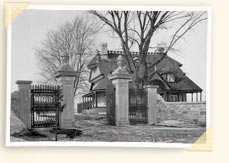 If I had been psychiatrist-in-chief
from 1947 to 1965… If I had been psychiatrist-in-chief
from 1947 to 1965…
I would probably be a man and would be known as the medical
superintendent of the Verdun Protestant Hospital. In 1947,
I would witness the introduction of group therapy within the
hospital—a very good idea in a hospital with 1,700 beds
and only 6 psychiatrists.
I would also, from 1950 to 1956,
approve 140 lobotomies, performed on patients in our operating
room. With great pride and sheer amazement, I would witness
in my own hospital, the ground-breaking introduction of chlorpromazine
for the treatment of schizophrenia in 1953, followed, within
4 years, by the equally momentous introduction of imipramine
for the treatment of depression. As melancholic clouds lifted
from our very depressed patients and paranoid fears allayed
in our schizophrenic patients, I would envision a bright future
with hope for the hopeless and the quietening of screams that
would often keep me awake on hot summer nights at Burland Villa.
The academic world would finally hear of the Verdun Protestant
Hospital and we would take a leadership position in the treatment
of severe mental disorders. In 1955, I would have the honour
of opening the doors of the asylum, as 4 out of 26 wards no
longer needed to be locked, thanks to the great strides being
made with new treatments. On a more sobering note, that very
same year, I would have to implement the 275 recommendations
generated by a visit from the central inspection board of the
American Psychiatric Association.
One of my biggest challenges
would be to come up with a way of establishing an outpatient
program and after-care clinic, as suggested by the inspectors—where
to begin? By 1956, with the help of the Social Services Department,
a plan would be hatched, and our home-care program launched.
Why not relieve overcrowding by allowing carefully-selected
patients to be discharged to a homelike environment in a supervised
foster home? In no time, 250 patients would leave the hospital
and, with regular visits from social workers and a monthly
examination by their doctor, many of them would never return.
Given that, in numerous aspects of our work, our volunteers
had become indispensable, we would be thrilled in 1958 when
the Auxiliary was formed and none other than Mrs. E. Hutchison
accepted the honorary presidency. The following year, under
pressure to improve our services, we would put into effect
a plan to separate patients over 65 from the rest. Why not
dedicate Porteous Pavilion to geriatrics? The staff would not
be so happy on moving day, but soon the transition would be
complete and the new Geriatrics Service in full swing.
There
would also be grumbling among staff about all the changes that
were taking place, but the real changes had not yet been set
in motion and we would soon begin a radical transformation
of VPH. With a great deal of persuasion and with the support
of Frank B. Common, president of our board, a major plan to
reorganize and modernize the hospital would be approved. It
would mean closing the farm—but not having our own eggs
and milk would be a small price to pay for finding the space
to develop our own child and adolescent services. Anyway, the
neighbours on Stephens Street, who had been bitterly complaining
about the noise from the pigs, would warmly welcome our new
plan.
By the 60’s, the hospital would become too big
to be run by one man. Although I had fully enjoyed the absolute
authority accorded to me as medical superintendent, and had
not minded being called the benign dictator behind my back,
I would see the advantages of the new law that would come into
effect in 1961 and stipulate that each hospital had to have
a medical board. By 1963, on the advice of the medical board,
the organisational structure would change and 3 leadership
positions would be created: executive director, medical superintendent
and assistant medical superintendent. I, of course, would become
the executive director.
«« Back
|